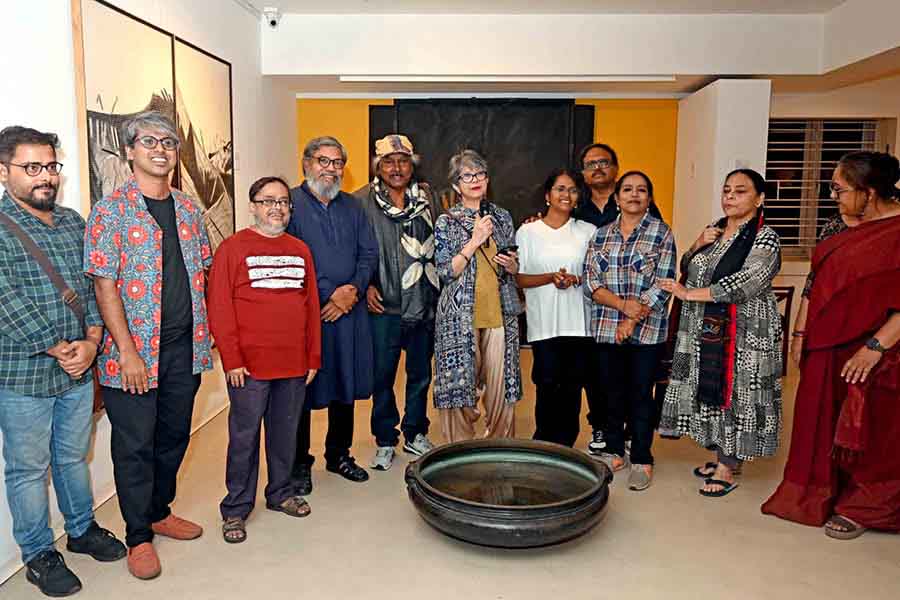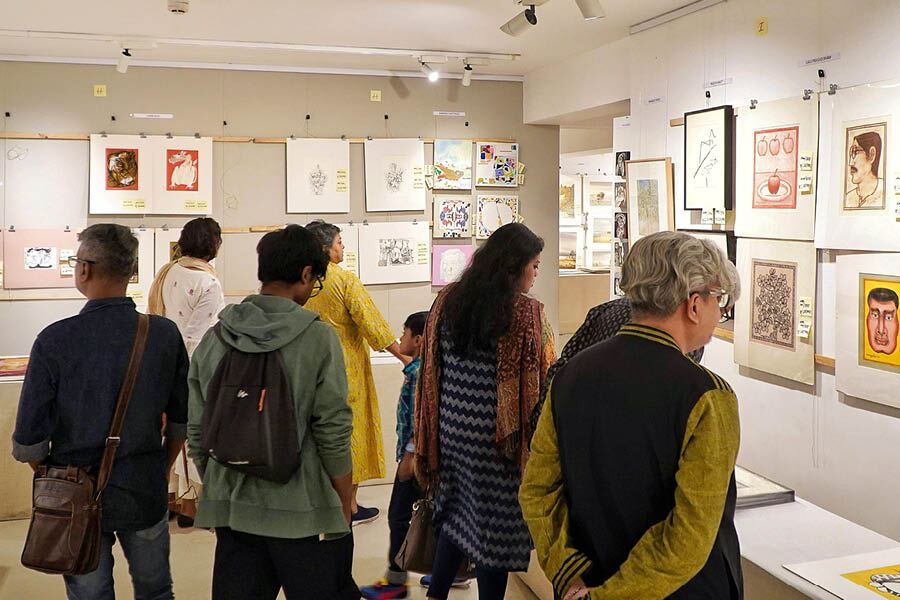“There is something about this exhibition that does not inspire either laughter or positivity,” said Pratiti Basu Sarkar, chief administrator of the Centre of International Modern Art, at the opening of the gallery’s new exhibition. “What it does inspire you to do is think.”
Sure enough, entering the exhibition in question — Shape Without Form, Shade Without Colour — makes the viewer feel as though they have crossed an intangible threshold and stepped into a fractured mirror reflecting the state of the modern world. Borrowing its title from T.S. Eliot’s haunting poem, ‘The Hollow Men’, Shape Without Form, Shade Without Colour, on till December 21, promises — and delivers — a visceral confrontation with the ruptures of our contemporary existence.
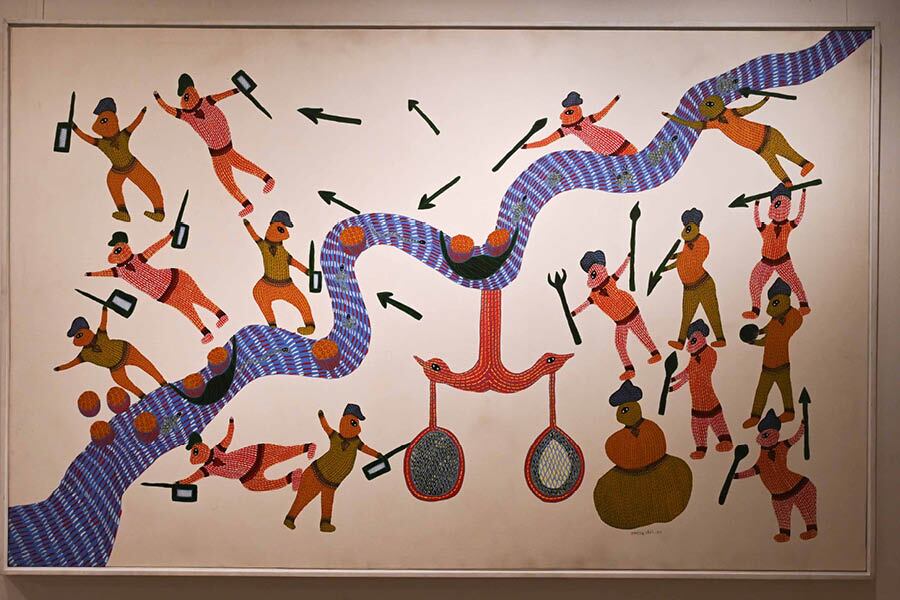
‘Swadhinta’ (Freedom) by Gond visual artist Ram Singh Urveti
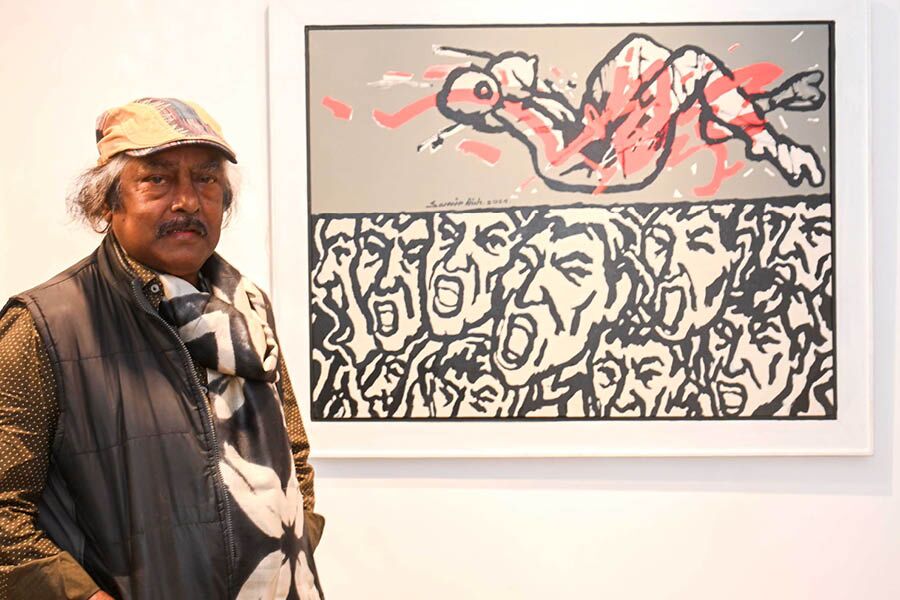
‘The Dark Night’ (private collection) by Samir Aich
Carefully curated to highlight a mix of iconic and emerging voices, CIMA’s latest exhibition forces the viewer to linger in discomfort, introspection, and, sometimes, despair. Moreover, by placing the works of iconic figures like Ganesh Pyne, Bikash Bhattacharjee and M.F. Husain alongside the voices of more contemporary artists like Ankan Bandyopadhyay, Rashmi Bagchi Sarkar and Manish Moitra, CIMA highlights the continuum of the artistic response and the way it adapts to societal challenges. This commitment to inclusivity not only elevates newer artists but also enriches the viewer’s experience by offering diverse interpretations of the world’s shared turmoil — a turmoil reflected in rapidly-changing landscapes, climate catastrophes, political upheaval, shrinking spaces for dissent on a national and global scale, and, of course, ongoing holocausts in war-ravaged parts of the world. Barood, by Kingshuk Sarkar, composed of exploded, modified firecrackers with carbon polymer and animal glue on canvas, is a stark reminder of such untold violence, and builds on the exhibition’s collective tableau of grief, resilience and self-reflection.
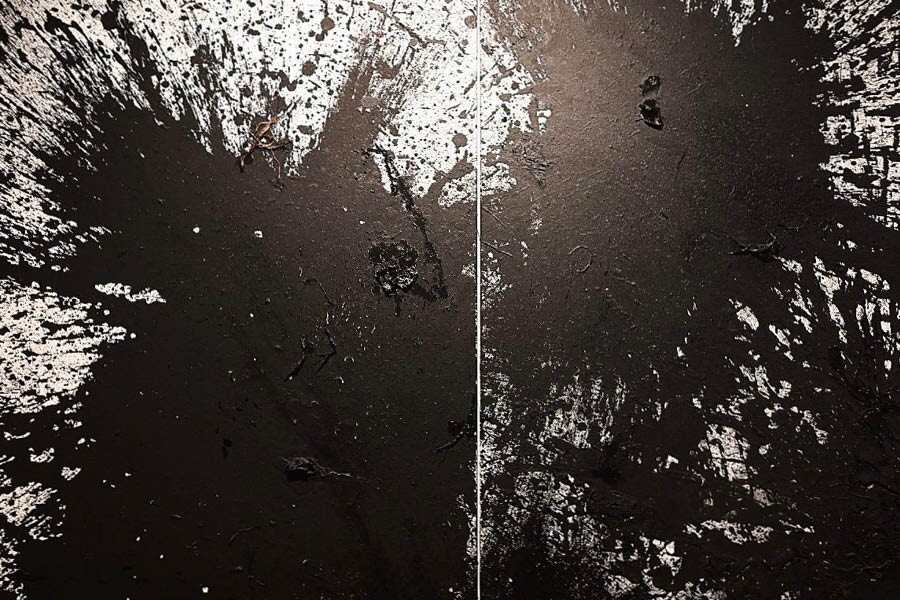
‘Barood’ by Kingshuk Sarkar
Of special interest, also, is the inclusion of Gond artist Ram Singh Urveti in Shape Without Form, Shade Without Colour. He brings a vital indigenous perspective to the exhibition, highlighting the universality of humanity’s struggles and aspirations. Gond art, with its intricate patterns and deeply symbolic motifs, is rooted in the storytelling traditions of the Gond tribe, one of the largest indigenous communities in India. It celebrates a profound connection with nature, community, and spirituality, often reflecting the cyclical rhythms of life. Urveti’s work, Swadhinta (Freedom), stands as a testament to resilience and liberation, weaving traditional Gond motifs, vibrant hues and meticulously drawn lines to evoke a sense of harmony and reclamation, suggesting that even amidst chaos and subjugation, freedom — whether personal, cultural, or ecological — is an enduring aspiration. Urveti’s presence in the exhibition not only amplifies the voice of India’s indigenous art traditions but also situates them within a broader, global conversation about equity, representation, and the interconnectedness of human experiences.
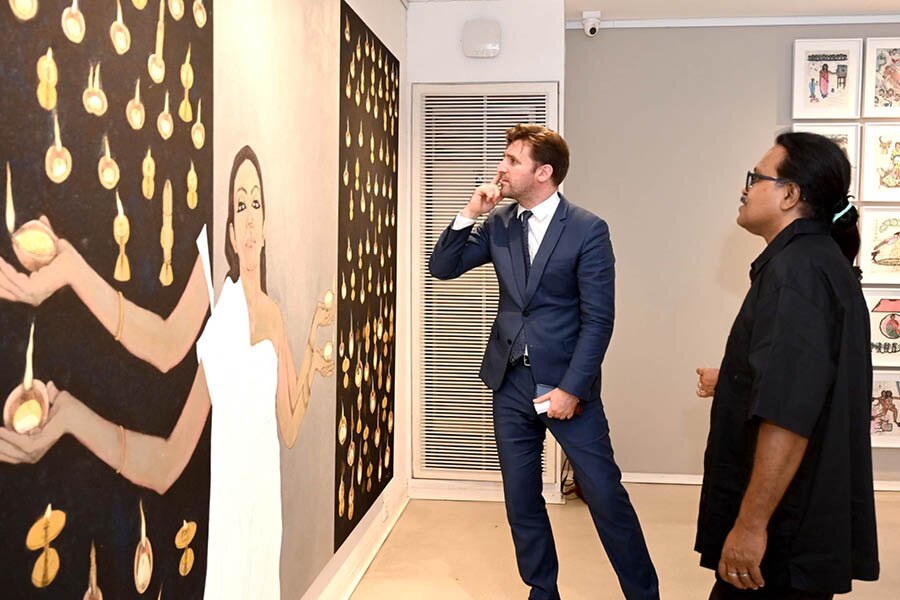
Nicolas Facino, director, Alliance Francais de Bengale, looks at a work by artist Sonal Varshneya, who was not present at the inauguration
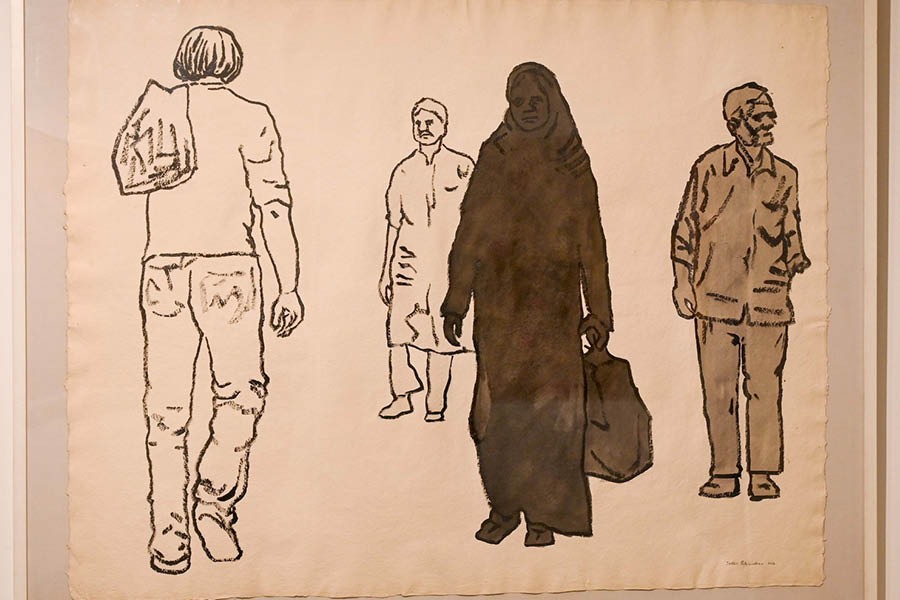
‘Four People’ by Sudhir Patwardhan
The presence of the works of artists like Ankan Bandyopadhyay and Manish Moitra presents to the viewer the perspective of a generation that is grappling with inherited chaos, yet finding ways to process and critique it. Bandopadhyay, who has two works on display at the exhibition — including his second work in the Sundarban to Sonarpur series — stands out for his meticulous framing and narrative depth. Influenced by the compositional techniques of Frank H. Taylor, Bandyopadhyay’s sketches and paintings invite viewers to see beyond the immediate image, discovering stories within the frame. Telling a story of migration and isolation through the use of colour and a unique medium, Bandopadhyay emphasises that every house and its minutest detail in front of the viewer’s eyes has been observed by him, in person. His gift for fine detailing evokes a sense of collective memory and loss, a poignant reflection on the dislocation and anonymity of modern life.
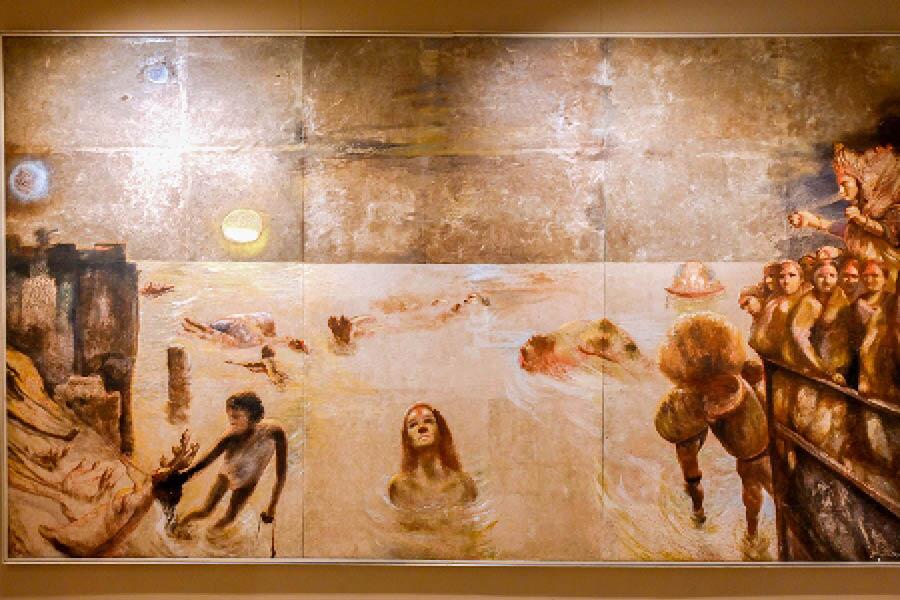
‘Visarjan’ by Bikash Bhattacharjee
But all eyes are eventually and invariably drawn to the massive canvas of Bikash Bhattacharjee’s vision — the sprawling Visarjan. With its haunting imagery juxtaposing the ethereal nature of worship with lived realities of death, deprivation and isolation, Bhattacharjee’s work evoked awe and despair, both from the artists present at the inauguration as well as visitors. As human figures take up the foreground — some in the crush of communal celebration, others in the throes of loss — the viewer almost feels like they’re observing the specific flow of a moving image… one which then sharply falls into a vast horizon of terror, or, worse, emptiness.
This terror and despair are, then, distilled into the starkly intense Poison — an installation by artist Bimal Kundu that makes no bones about the slow and steady poisoning of the nation-state. When Kundu invites the viewer to take a closer look, one sees, at first, a headless body shrouded in faded leather, with the absence of its head punctuated by the cold, blue glow of an LED light. “I wanted to represent the poison coursing through the veins of individuals and the nation at present,” said Kundu, highlighting art’s singular power to encourage and enact critique and dissent. In the serpent slithering up the corpse’s chest, one cannot help but note the magnitude of the crisis at hand — a darkness depicted succinctly through the stark, minimalistic tableau. Kundu masterfully provokes introspection on the slow poison of a nation in decay — and, by extension, humanity’s collective struggles.
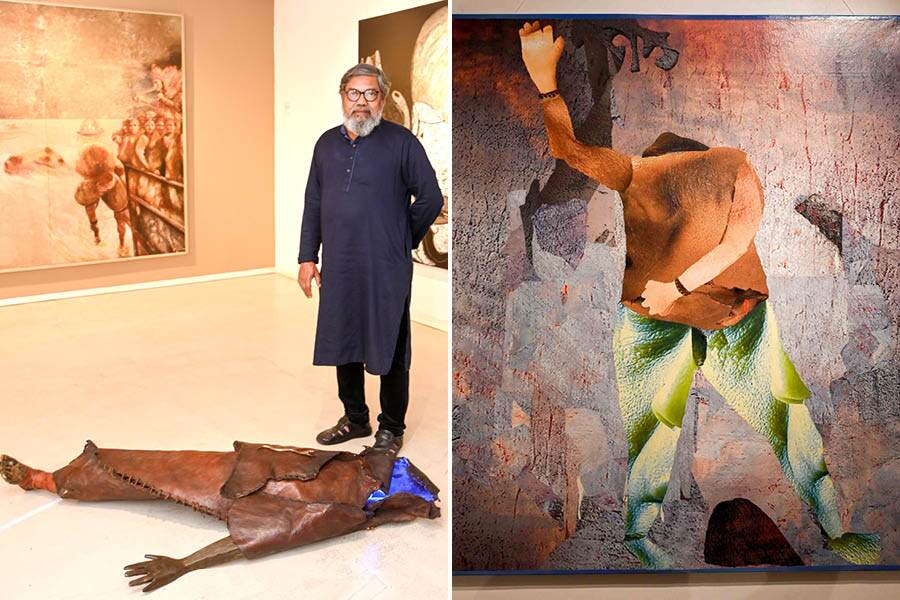
(Left) ‘Poison’ by Bimal Kundu; (right) an untitled work by Shakila
Thus, uniting these diverse voices is the shared reckoning with the shadows of our world. The curatorial choice to anchor the exhibition in Eliot’s poem is astute; the poet’s evocation of paralysis, emptiness and spiritual decay finds profound resonance in the works on display. At its core, Shape Without Form, Shade Without Colour is not just a showcase of individual brilliance but a cohesive narrative about humanity’s precarious state. The exhibition’s strength lies in its refusal to sugarcoat the desperation of the modern world as we have built it, and even stops short of offering hope. In fact, it forces its viewers to wrestle with difficult truths, offering no easy answers but, instead, plenty of questions.
An unsettling realisation dawns upon the viewer upon walking out of the gallery: the turmoil within these frames is not confined to them. It spills over onto the streets of the city, into regular conversations, and into the fabric of people’s daily lives. Perhaps this is art as a call to consciousness — a reminder that while the world may be under siege, the act of witnessing is, in itself, a form of resistance?
Shape Without Form, Shade Without Colour is on display till December 21 at CIMA Gallery.
